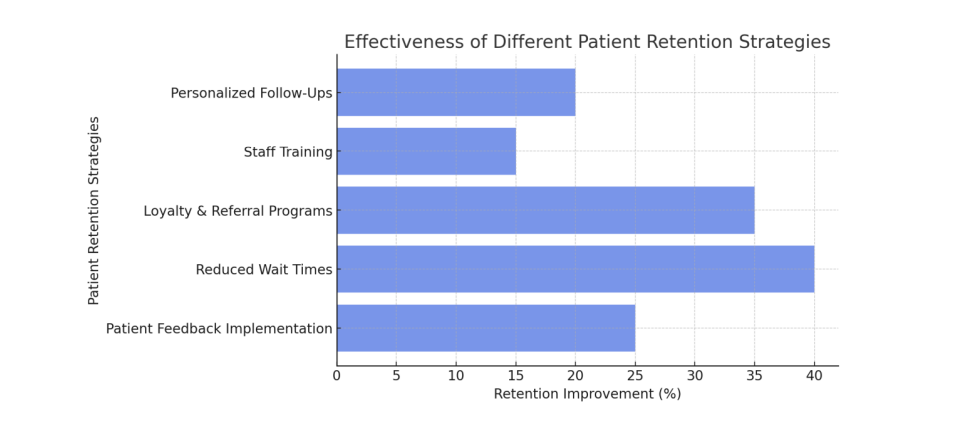Why Patient Retention Matters:
Did you know that loyal patients spend 67% more on healthcare services compared to new
patients? (Bain & Company). Yet, many health and wellness businesses focus more on attracting
new clients rather than nurturing the ones they already have.
The result? Lost revenue, decreased trust, and a revolving door of one-time patients.
If you want to build long-term relationships with your patients and increase your lifetime
customer value, here are five proven strategies to boost patient retention and loyalty
1. Personalize Communication & Follow-Ups
Stat: 81% of patients say that timely follow-ups improve satisfaction (Healthgrades).
Patients don’t just want treatment—they want care. The more personalized your
communication, the stronger the patient connection.
How to Implement This:
✅ Use automated email & text reminders for upcoming appointments.
✅ Send personalized messages on birthdays or anniversaries with your practice.
✅ Provide post-appointment follow-ups to check in on patient progress.
Example: A chiropractic clinic saw a 20% increase in returning patients simply by sending
automated follow-up emails within 48 hours of an appointment.
2. Train Your Staff to Deliver Exceptional Service
Stat: 52% of patients switch providers due to poor customer service (Accenture).
Your front desk staff and healthcare team are the first and last impression of your business. If
they lack empathy, efficiency, and professionalism, your patient retention will suffer.
How to Implement This:
✅ Conduct quarterly customer service training for your team.
✅ Train staff to use active listening techniques to improve patient communication.
✅ Teach de-escalation techniques for handling difficult patient interactions.
Example: A wellness center introduced monthly role-playing exercises for staff to practice
patient interactions, leading to a 15% increase in patient satisfaction scores.
3. Implement a Loyalty & Referral Program
Stat: 70% of patients prefer providers who offer rewards for loyalty (Healthcare
Consumer Trends).
Patient loyalty shouldn’t be taken for granted—it should be rewarded. Referral and loyalty
programs create an incentive for patients to stay engaged with your practice.
How to Implement This:
✅ Offer a discount or free service after a certain number of visits.
✅ Give patients a referral bonus for bringing in new clients.
✅ Provide a membership option with exclusive perks for repeat patients.
Example: A physical therapy clinic introduced a “5th Visit Free” loyalty card, leading to a
35% increase in repeat visits.
4. Reduce Wait Times & Improve Scheduling
Stat: 30% of patients have left a provider due to long wait times (JAMA Network).
No one likes waiting forever in a lobby. The longer the wait, the less likely a patient will return.
How to Implement This:
✅ Use AI-powered scheduling to avoid overbooking.
✅ Offer virtual check-ins and text notifications to reduce wait frustration.
✅ Implement streamlined intake forms to speed up new patient onboarding.
Example: A dermatology clinic reduced patient no-shows by 40% by using an AI-based
scheduling system that automatically suggested alternative time slots for cancellations.
5. Collect & Act on Patient Feedback
Stat: 85% of patients are more likely to return if they feel their feedback is valued
(Forbes).
Most businesses ask for feedback—but few actually use it to improve. Patients want to see that
their concerns are being addressed.
How to Implement This:
✅ Use QR codes in your office for quick & anonymous feedback.
✅ Send post-visit surveys via email or text.
✅ Actively respond to online reviews (both positive & negative).
Example: A family practice improved its Google rating from 3.8 to 4.6 stars in six months by
implementing a real-time patient feedback system and addressing concerns immediately.

Final Thoughts: The Key to Long-Term Patient Loyalty
Retaining existing patients is 5x cheaper than acquiring new ones (Harvard Business Review).
Investing in customer experience & patient engagement pays off in higher retention, more
referrals, and better revenue. The smallest changes—like a friendly follow-up email or an
optimized scheduling system—can have the biggest impact.
Which strategy will you implement first?
Sources Cited:
Bain & Company – The Value of Customer Retention in Healthcare
Healthgrades – Patient Satisfaction & Retention Study
Accenture – The Importance of Customer Service in Healthcare
JAMA Network – How Wait Times Impact Patient Loyalty
Forbes – The Role of Patient Feedback in Healthcare Business Growth

